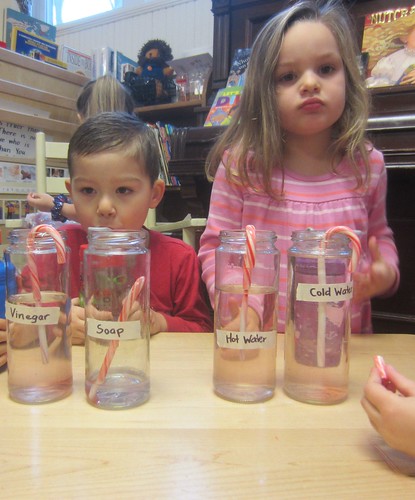 The children were on the go, gliding over the packed snow as they pulled friends in sleds all around the yard. We made rainbow snow all over the playground by spraying colored water wherever we found nice white patches of snow.
The children were on the go, gliding over the packed snow as they pulled friends in sleds all around the yard. We made rainbow snow all over the playground by spraying colored water wherever we found nice white patches of snow.

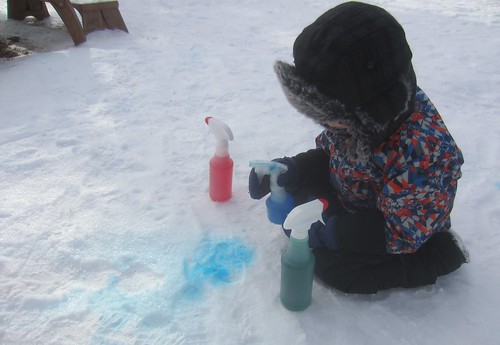





 Monday students did some winter night pictures by using pastels on black paper. We tried writing on the black paper with markers, colored pencils, and crayons, and discovered that they were all hard to see and not very bright. We then tested out the pastels and found that they created vibrant pictures on dark paper. Some beautiful works of art were created and posted on the wall!
Monday students did some winter night pictures by using pastels on black paper. We tried writing on the black paper with markers, colored pencils, and crayons, and discovered that they were all hard to see and not very bright. We then tested out the pastels and found that they created vibrant pictures on dark paper. Some beautiful works of art were created and posted on the wall!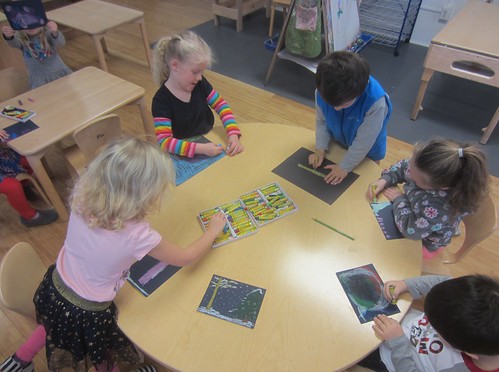

 We learned about several different fall/winter celebrations this week. On Tuesday we learned about Diwali, a primarily Hindu celebration, which is very popular in India, and has expanded to other religions as well, each with their own stories and traditions. We watched a National Geographic video about the November celebration of Diwali and read a story about four children who share their Diwali traditions with their class. We learned that statues of the goddess Lakshmi, the goddess of wealth, are displayed during this time. Rangoli designs are created from sand, typically in the shape of a lotus blossom, in the entryways of homes, special treats and foods are enjoyed and shared with friends and neighbors, fireworks are set off, and diyas (oil lamps) are lit. The children colored in Rangoli designs throughout the week.
We learned about several different fall/winter celebrations this week. On Tuesday we learned about Diwali, a primarily Hindu celebration, which is very popular in India, and has expanded to other religions as well, each with their own stories and traditions. We watched a National Geographic video about the November celebration of Diwali and read a story about four children who share their Diwali traditions with their class. We learned that statues of the goddess Lakshmi, the goddess of wealth, are displayed during this time. Rangoli designs are created from sand, typically in the shape of a lotus blossom, in the entryways of homes, special treats and foods are enjoyed and shared with friends and neighbors, fireworks are set off, and diyas (oil lamps) are lit. The children colored in Rangoli designs throughout the week.
Susan shared the traditions of Saint Lucia, which is celebrated in Scandinavia, but primarily Sweden. Saint Lucia is based on the legend of Lucia (a 4th century saint) arriving in a glowing white boat with her head framed in light, bringing food to save a town from famine. She told of the primary traditions associated with the holiday. Girls dress all in white with a red sash. The oldest girl in the family wears a wreath with candles as a crown and wakes the family by singing the song “Santa Lucia” and carrying special buns and hot drinks to the family. Whole towns have processions, too. Boys carry star wands and girls wear wreath crowns and carry candles. It’s the official beginning of the Yuletide season in Sweden. The children created their own green paper crowns with shining candles, and sparkling star wands. Susan also talked about the Danish tradition of Jul Nissen (elves) that appear throughout people’s houses for children to find throughout the season. They are supposed to bring good luck. The children had a fabulous time coloring and cutting out elves to hide all over the classroom! Can you spy the elves?
Susan also talked about the Danish tradition of Jul Nissen (elves) that appear throughout people’s houses for children to find throughout the season. They are supposed to bring good luck. The children had a fabulous time coloring and cutting out elves to hide all over the classroom! Can you spy the elves?




 The pencil holders that the children have been diligently working on for the past two months were completed on Wednesday. Each child chose to drill two or three holes for pencils, then used Mr. Bond’s hand drill to crank it around and around to drill out the holes. Everyone finished in time to take their holder home. Thank you so much to Mr. Bond for such an amazing project and so many new experiences with ordering the steps, following directions, working with different tools, building up finger, hand, arm, and core muscles, and focusing to carefully and safely use the tools. It has been such an amazing first part of the year in woodworking!
The pencil holders that the children have been diligently working on for the past two months were completed on Wednesday. Each child chose to drill two or three holes for pencils, then used Mr. Bond’s hand drill to crank it around and around to drill out the holes. Everyone finished in time to take their holder home. Thank you so much to Mr. Bond for such an amazing project and so many new experiences with ordering the steps, following directions, working with different tools, building up finger, hand, arm, and core muscles, and focusing to carefully and safely use the tools. It has been such an amazing first part of the year in woodworking!
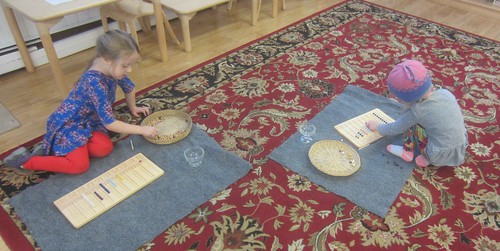












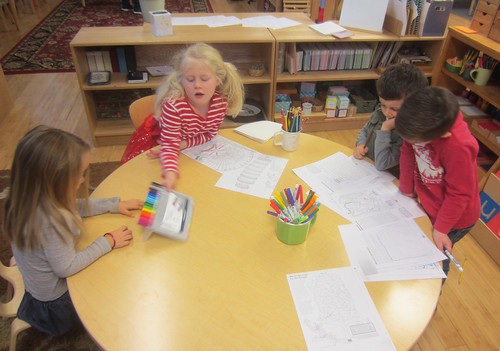
 Our week was dedicated to practicing for our performance. The children listened and participated so well. They followed instructions about lining up, following in line, singing clearly, watching Susan, attending to the cues, and listening quietly. They were very impressive with their practicing and the Thursday night Winter Performance was truly spectacular! They definitely showed off their hard work! Thank you to Chad Fillion of Phlume Media, who video taped the performance for all families to access. We so appreciate it!! A lin Thank you to everyone for joining us to celebrate this season together. It was wonderful to gather together with everyone. We so appreciate your contributions to the pot luck and your help cleaning up after – it was the quickest clean up we have had yet!
Our week was dedicated to practicing for our performance. The children listened and participated so well. They followed instructions about lining up, following in line, singing clearly, watching Susan, attending to the cues, and listening quietly. They were very impressive with their practicing and the Thursday night Winter Performance was truly spectacular! They definitely showed off their hard work! Thank you to Chad Fillion of Phlume Media, who video taped the performance for all families to access. We so appreciate it!! A lin Thank you to everyone for joining us to celebrate this season together. It was wonderful to gather together with everyone. We so appreciate your contributions to the pot luck and your help cleaning up after – it was the quickest clean up we have had yet! Friday students did a fun candy cane experiment. They placed candy canes in four jars, then filled the jars with different liquids – vinegar, soap, hot water, and cold water. We then made predictions about which liquid we thought would dissolve the candy cane the fastest. Seven students hypothesized that the hot water would work the fastest, and one hypothesized that the cold water would be fastest. We then observed to determine which it was. The hot water did dissolve the candy cane most quickly, with vinegar following closely behind, and cold water following as the third fastest.
Friday students did a fun candy cane experiment. They placed candy canes in four jars, then filled the jars with different liquids – vinegar, soap, hot water, and cold water. We then made predictions about which liquid we thought would dissolve the candy cane the fastest. Seven students hypothesized that the hot water would work the fastest, and one hypothesized that the cold water would be fastest. We then observed to determine which it was. The hot water did dissolve the candy cane most quickly, with vinegar following closely behind, and cold water following as the third fastest.



